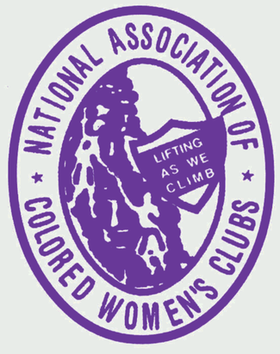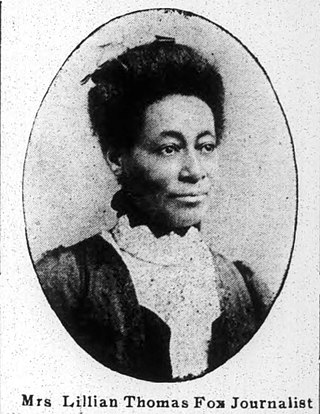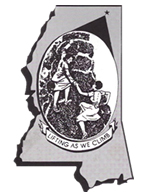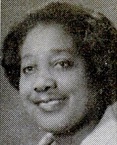
The National Association of Colored Women's Clubs (NACWC) is an American organization that was formed in July 1896 at the First Annual Convention of the National Federation of Afro-American Women in Washington, D.C., United States, by a merger of the National Federation of Afro-American Women, the Woman's Era Club of Boston, and the Colored Women's League of Washington, DC, at the call of Josephine St. Pierre Ruffin. From 1896 to 1904 it was known as the National Association of Colored Women (NACW). It adopted the motto "Lifting as we climb", to demonstrate to "an ignorant and suspicious world that our aims and interests are identical with those of all good aspiring women." When incorporated in 1904, NACW became known as the National Association of Colored Women's Clubs (NACWC).

Josephine St. Pierre Ruffin was a publisher, journalist, civil rights leader, suffragist, and editor of the Woman's Era, the first national newspaper published by and for African-American women.

Mary Burnett Talbert was an American orator, activist, suffragist and reformer. In 2005, Talbert was inducted into the National Women's Hall of Fame.

Indiana Avenue is a historic area in downtown and is one of seven designated cultural districts in Indianapolis, Indiana. Indiana Avenue was, during its glory days, an African American cultural center of the area. The Indiana Avenue Historic District within the area was designated a United States national historic district in 1987.

Sallie Wyatt Stewart was an American educator and a social services organizer for the black community in Evansville, Indiana, who is best known for her leadership in local, state, and national black women’s clubs. Stewart served as president of the Indiana Federation of Colored Women from 1921 to 1928 and succeeded Mary McLeod Bethune as president of the National Association of Colored Women from 1928 to 1933. During her term as the IFCW's president, Stewart launched "The Hoosier Woman", a monthly newsletter that served as the organization's official publication. Among her accomplishments as the NACW's president was the founding in 1930 of the National Association of Colored Girls. In addition, Stewart was a delegate in 1930 to the International Council of Women in Vienna, Austria, and fourth vice president of the National Council of Women of the United States. She also served a trustee and secretary of the Frederick Douglass Memorial and Historical Association, a member of the executive committee of the National Negro Business League, a member of the executive committee of the National Colored Merchants Association, and a teacher in the Evansville public schools for more than fifty years.

The Athenæum, originally named Das Deutsche Haus, is the most ornate and best-preserved building affiliated with the German American community of Indianapolis. Once used as a German American Turnverein and clubhouse, it currently houses many groups, organizations, and businesses. The Athenæum is located across Massachusetts Avenue from the Old National Centre. It was placed on the National Register of Historic Places on February 21, 1973. On October 31, 2016, it was named the 41st National Historic Landmark in Indiana.

The Bethel A.M.E. Church, known in its early years as Indianapolis Station or the Vermont Street Church, is a historic African Methodist Episcopal Church in Indianapolis, Indiana. Organized in 1836, it is the city's oldest African-American congregation. The three-story church on West Vermont Street dates to 1869 and was added to the National Register in 1991. The surrounding neighborhood, once the heart of downtown Indianapolis's African American community, significantly changed with post-World War II urban development that included new hotels, apartments, office space, museums, and the Indiana University–Purdue University at Indianapolis campus. In 2016 the congregation sold their deteriorating church, which will be used in a future commercial development. The congregation built a new worship center at 6417 Zionsville Road in Pike Township, Marion County, Indiana.

Lillian May Parker Thomas Fox was an African-American journalist, clubwoman, public speaker, and civic activist in Indianapolis, Indiana, who rose to prominence in the 1880s and 1890s as a writer for the Indianapolis Freeman, a leading national black newspaper at the time. In 1900 Fox joined the Indianapolis News, becoming the first African-American columnist to regularly write for a white newspaper in Indiana. She was inducted into the Indiana Journalism Hall of Fame in 2014.

The Northeastern Federation of Colored Women's Clubs (NFCWC) is an umbrella organization representing black women's clubs in the northeastern United States. The organization was affiliated with the National Association of Colored Women's Clubs (NACWC). It was the first umbrella organization for black women's clubs in the United States, predating the NACWC by a month. The motto of the club is "For God and Humanity".

Julian–Clark House, also known as the Julian Mansion, is a historic home located at Indianapolis, Marion County, Indiana. It was built in 1873, and is a 2+1⁄2-story, Italianate style brick dwelling. It has a low-pitched hipped roof with bracketed eaves and a full-width front porch. It features a two-story projecting bay and paired arched windows on the second story. From 1945 to 1973, the building housed Huff's Sanitarium.

The Propylaeum, also known as the John W. Schmidt House or as the Schmidt-Schaf House, is a historic home and carriage house located at 1410 North Delaware Street in Indianapolis, Marion County, Indiana. The Propylaeum was named after the Greek word "propýlaion," meaning "gateway to higher culture." The property became the headquarters for the Indianapolis Woman's Club in 1923, as well as the host for several other social and cultural organizations. It was initially built in 1890-1891 as a private residence for John William Schmidt, president of the Indianapolis Brewing Company, and his family. Joseph C. Schaf, president of the American Brewing Company of Indianapolis, and his family were subsequent owners of the home.

The woman's club movement was a social movement that took place throughout the United States that established the idea that women had a moral duty and responsibility to transform public policy. While women's organizations had always been a part of United States history, it was not until the Progressive era that it came to be considered a movement. The first wave of the club movement during the progressive era was started by white, middle-class, Protestant women, and a second phase was led by African-American women.

The Mississippi State Federation of Colored Women's Clubs, Inc (MSFCWC) is an African American woman's club located in Mississippi. The umbrella organization, affiliated with the National Association of Colored Women (NACW) was founded in 1903. The headquarters of the club are located in Jackson. The organization had an annual convention and was organized into committees. MSFCWC sponsored scholarship opportunities, and provided resources for black people in Mississippi.

The South Carolina Federation of Colored Women's Clubs (SCFCWC) was an African American women's club founded in 1909 in South Carolina. The umbrella organization was created by Marion Birnie Wilkinson, Sara B. Henderson, Lizella A. Jenkins Moorer, Celia Dial Saxon and other women who met at Sydney Park Church in Columbia. They adopted the motto of the National Association of Colored Women's Clubs (NACWC), "Lifting as We Climb." Wilkinson became the first president and worked towards improving education and living conditions for black people in South Carolina. The organization grew to have twenty-five hundred members in 1922. One of the major accomplishments of the SCFCWC was the creation of the Wilkinson Home for Colored Girls in Cayce. The home was originally for girls who had been deemed "delinquent" and later housed orphans.
The Woman's Improvement Club of Indianapolis, Indiana, was formed in 1903 by Lillian Thomas Fox, Beulah Wright Porter, and other prominent African American women as a small literary group to improve their education, but it was especially active and best known for its pioneering efforts to provide facilities to care for the city's African American tuberculosis patients from 1905 to the mid-1930s. The clubwomen also supported the war effort during World War I and provided social service assistance to Indianapolis's impoverished residents and its African American youth. By 1960, when tuberculosis was no longer a major health threat, the club continued its support of the local black community in other ways, such as a visiting nurse program and scholarships to students graduating from Crispus Attucks High School students. In the mid-1960s, after its membership significantly declined, its records were donated to the Indiana Historical Society.

The Topeka Council of Colored Women's Clubs Building was the clubhouse of the Topeka Council of Colored Women's Clubs (TCCWC). It was listed on the National Register of Historic Places in the United States in 2009. It is located in Topeka, Kansas.

Henry Johnson Richardson Jr. was a civil rights lawyer and activist, a member of the Indiana House of Representatives (1932–36), and a judge in Marion County, Indiana. He helped secure passage of Indiana's school desegregation law in 1949 and for organizing the Indianapolis Urban League in 1965. In 1932, he was one of the first two African Americans elected on the Democratic Party ticket to the state house, Richardson was also a leader in gaining passage of state laws that integrated the Indiana National Guard, ended racial discrimination in public accommodations and in Indiana University's student housing, and secured a fair employment practices law for public-works projects. In addition, Richardson won a landmark public housing discrimination case in 1953.

Mamie Bynes Reese was an American clubwoman, college professor, and Georgia state official.

Vida Newsom was an American suffragist and clubwoman, based in Columbus, Indiana. She was described in a 1925 headline as "One of State's Busiest Women."




















